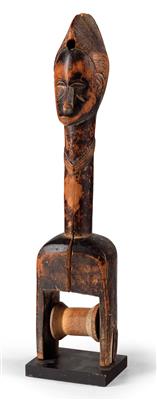Guro, Ivory Coast: a tall heddle pulley, with a fine and typical head of a Guro woman above.
Guro, Ivory Coast: a tall heddle pulley, with a fine and typical head of a Guro woman above.

In Africa, it is usually men who do the weaving. Above the reels of heddle pulleys, such as present one, runs a cord, by which the weaver, using foot pedals, can separate the warp threads into so-called ‘fans’. Then the weaver ‘shoots’ the weft threads transversally through the ‘fan’. Thus, fabric is created. These heddle pulleys are particularly finely carved so that the weavers, who sit for the entire day at their looms, might have ‘something beautiful’ in front of their eyes.
This is particularly apparent in the present heddle pulley, executed by a carver of the Guro people: carved out of lightweight, light-coloured wood in a single piece, and originally dyed black. On the holster of the heddle (below), an especially beautiful head of a Guro woman sits on a long neck (with decorative scarification marks on the back and wearing a necklace). The head under its typical crested coiffure is pierced. Through the hole ran the cord with which the heddle pulley was hung up on the loom in front of the face of the weaver. The face of the woman shows the characteristic features of the Guro style: narrow, long and elegant. With a high forehead, eyebrows, long, narrow nose and a slightly protruding, small mouth. On each cheek, a diagonal decorative scarification mark can be seen. Stylistically, a magnificently crafted piece, with colour scuffing due to age, minimal breaks above and a crack to the right side of the head and below on the front. Nevertheless, with an impressive old patina as a result of very long use.
Height: c. 29 cm. First third of the 20th century. (ME)
Provenance: Sale, Neumeister, Munich, 11.11.2010; currently: Dr. Karl-Ferdinand Schädler, Munich.
Esperto: Prof. Erwin Melchardt
 Prof. Erwin Melchardt
Prof. Erwin Melchardt
+43-1-515 60-465
erwin.melchardt@dorotheum.at
06.04.2017 - 15:00
- Prezzo di partenza:
-
EUR 800,-
Guro, Ivory Coast: a tall heddle pulley, with a fine and typical head of a Guro woman above.
In Africa, it is usually men who do the weaving. Above the reels of heddle pulleys, such as present one, runs a cord, by which the weaver, using foot pedals, can separate the warp threads into so-called ‘fans’. Then the weaver ‘shoots’ the weft threads transversally through the ‘fan’. Thus, fabric is created. These heddle pulleys are particularly finely carved so that the weavers, who sit for the entire day at their looms, might have ‘something beautiful’ in front of their eyes.
This is particularly apparent in the present heddle pulley, executed by a carver of the Guro people: carved out of lightweight, light-coloured wood in a single piece, and originally dyed black. On the holster of the heddle (below), an especially beautiful head of a Guro woman sits on a long neck (with decorative scarification marks on the back and wearing a necklace). The head under its typical crested coiffure is pierced. Through the hole ran the cord with which the heddle pulley was hung up on the loom in front of the face of the weaver. The face of the woman shows the characteristic features of the Guro style: narrow, long and elegant. With a high forehead, eyebrows, long, narrow nose and a slightly protruding, small mouth. On each cheek, a diagonal decorative scarification mark can be seen. Stylistically, a magnificently crafted piece, with colour scuffing due to age, minimal breaks above and a crack to the right side of the head and below on the front. Nevertheless, with an impressive old patina as a result of very long use.
Height: c. 29 cm. First third of the 20th century. (ME)
Provenance: Sale, Neumeister, Munich, 11.11.2010; currently: Dr. Karl-Ferdinand Schädler, Munich.
Esperto: Prof. Erwin Melchardt
 Prof. Erwin Melchardt
Prof. Erwin Melchardt
+43-1-515 60-465
erwin.melchardt@dorotheum.at
|
Hotline dell'acquirente
lun-ven: 10.00 - 17.00
kundendienst@dorotheum.at +43 1 515 60 200 |
| Asta: | Tribal Art |
| Tipo d'asta: | Asta in sala |
| Data: | 06.04.2017 - 15:00 |
| Luogo dell'asta: | Wien | Palais Dorotheum |
| Esposizione: | 01.04. - 06.04.2017 |
